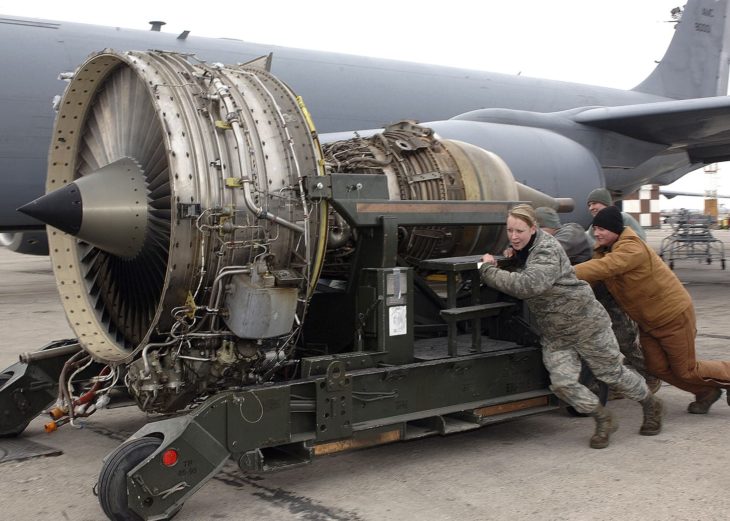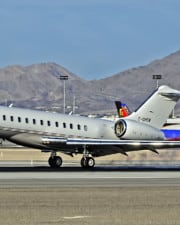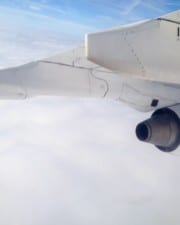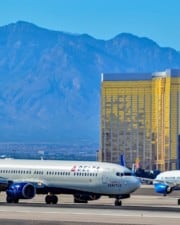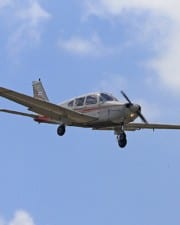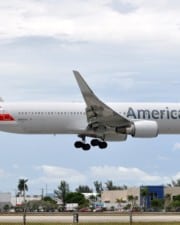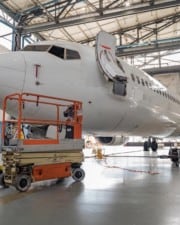What most people describe as a jet engine usually encompasses several different engine designs. In the early days, the turbojet dominated the skies and changed aviation forever. It is, after all, where the term “jet” came from. But in the years since, the technology has been tweaked and improved. The jet engine you find on most modern aircraft is actually a turbofan. So what’s the difference?
Table of Contents
A turbojet engine is a gas turbine engine that uses its exhaust to create thrust, while a turbofan engine uses its own fan for thrust. The main difference between the two engines is in their construction and design. A turbofan has an additional fan at the front of the engine which takes some air from outside of it and blows it through the core of the engine, where combustion happens before sending it back out to create forward thrust. This provides more efficient operation by allowing more airflow into and out of the engine than a turbojet can provide on its own.
Turbojets
Turbojets are the original jet-powered aircraft. These use a straight turbine to create thrust. They have poor efficiency at slow speeds, which limits their usefulness in anything other than aircraft.
A turbine works by compressing the air to very high pressures and temperatures, then injecting fuel into it in the combustion chamber. The explosive combustion of that fuel spins the turbine blades and driveshaft, which keeps the engine running.
The exhaust exits the back of the engine, and the pure force of the exhaust pressure drives the airplane forward like a rocket ship. The exhaust creates a rearward force, and as Newton famously observed, there is an equal and opposite reaction for every action. In this case, the aircraft is propelled forward.
Like the reciprocating engine, one of the neat things about the turbine is its interconnectedness. The compressor blades are powered by the combustion process thanks to them sharing a single drive shaft with the turbine.
Jet Engine History
The first designs for the gas turbine engine were created during the run-up to World War II. In 1928, British Frank Whittle submitted his ideas to the Royal Air Force. However, the Brits were slow to develop the technology and were outpaced by German engineer Hans von Ohain in 1935.
The German Heinkel HE-178 was the world’s first turbojet-powered aircraft. It flew in 1939. The British Gloster E.28/39 didn’t fly until 1941. Both aircraft were test platforms for their later warplanes that would enter service at the end of the war—the German Messerschmitt Me-262 and the British Gloster Meteor.
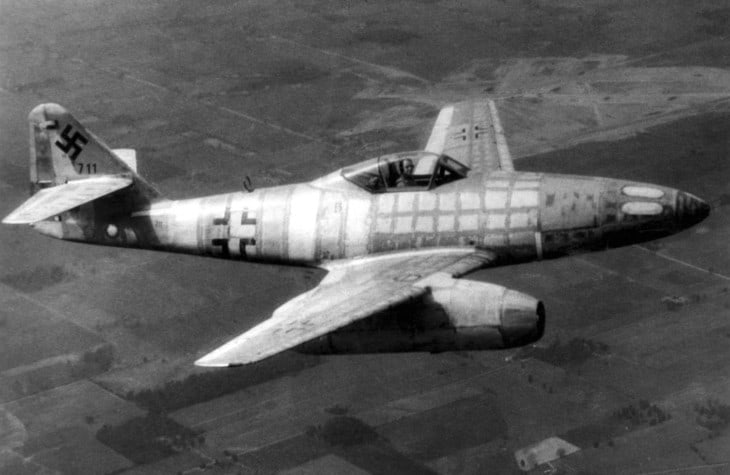
While the technology wasn’t used long enough to make a big difference in the outcome of the war, it did impact the aviation industry dramatically after the war ended.
Compared to the old piston engines, turbines offered a massive improvement in reliability and reduced maintenance. Airliners could now be designed with two engines instead of three or four. The first airliner to use turbines was the de Havilland Comet, first flown in 1949. The design had severe flaws, however, and was not considered a success.
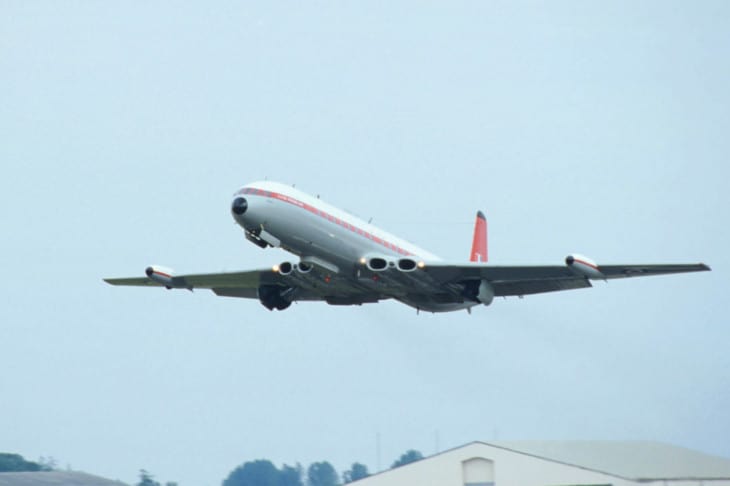
The first genuinely successful turbojet-powered airliner was the Boeing 707. It first flew in 1954 and is credited with beginning the “Jet Age.”
Turbojet Engines Today
Turbojet engines are not very common in new aircraft designs.
For low altitude operations, turboprop configurations are now the prevalent design. These take a conventional turbojet and marry it with a propeller. Since turbine engines spin so fast, a gearbox reduces the shaft speed to an appropriate speed to drive the propeller.
A turboprop aircraft derives its thrust from the propeller and not from the turbine itself. As a result, turboprops are the most efficient engines to drive aircraft that operate below 300 knots.
For high-altitude and high-speed operations, turbofans are now the favored technology.
Turbojets are still valuable in supersonic aircraft, where their efficiency improves dramatically.
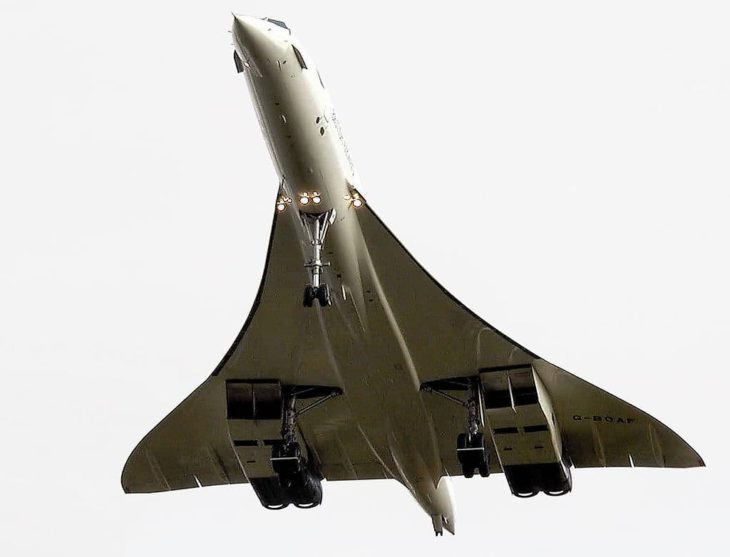
Turbofans
Turbofans are an improvement on the turbojet design that uses some of the advantages of the turboprop. Instead of driving an external propeller, however, the engine drives a large fan.
The first designs were worked up in the early 1960s, and the Lockheed C-5 Galaxy transport plane was one of the first aircraft to feature turbofan engines. Perhaps more famously, the Boeing 747 was one of the first airliners with them, and it first flew in 1969.

Visually, the fan is what you see in images of massive airliner engines. The actual turbine engine is smaller and behind that big fan. So what’s the advantage of having this fan?
For one thing, it ducts air around the turbine at the core of the engine. This creates a cushion effect that keeps turbine temperatures down and increases its efficiency. It also creates a sound barrier that reduces the engine’s noise level.
The bypass ratio, or BPR, of a turbofan engine is the amount of air ducted around the turbine core versus the amount that enters the core. An engine with a BPR of 10:1 means that for every 10 kg of air passing through the fan and around the core, only 1 kg goes through the core turbine.
A small amount of thrust is derived from the spinning fan blade, but a majority comes from the turbine itself, as is the case with a conventional turbojet.

Turbofans are described in terms of their BPR. A higher BPR provides lower fuel consumption but produces the same thrust. Airliner engines are high-bypass-ratio (HBPR) engines because the fan is significantly larger than the core turbine.
How are Turbojets Similar to Turbofans?
The operation and construction of the two types of engines are similar. In fact, the inner workings of a turbofan engine look identical to a turbojet—everything except the fan is the same.
Both engines work well at the same altitudes on the same types of aircraft. In addition, both engines burn the same type of fuel.
How are Turbojets Different than Turbofans?
The most significant difference is the age of the technology. Turbojets were the first generation of jets that powered fighters, bombers, and airliners.
For example, turbojets were used on the old Boeing 707s, 727s, and the very first versions of the 737s. Every model of 737, starting with the 737-300, has featured turbofan engines.
Turbojets differ from turbofans in a few areas. They are:
- Noisier
- Less efficient
- Shaped differently in appearance
Turbojet engines are incredibly noisy. Many airports, cities, states, and countries now impose noise limits on aircraft. As a result, to keep older turbojet aircraft flying, operators have had to outfit them with expensive “hush kits” to quiet them down.
This leads us to another significant difference between the two engines—efficiency. Turbofans have taken over as the dominant type of jet engine because they burn less fuel and produce fewer emissions. Airlines operating their planes day in and day out, even minor efficiency improvements mean considerable savings in dollars of operation cost.
From the outside view, turbojets are longer and thinner looking than turbofans. Turbofans are found on all modern airliners. If you compare a picture of the original 737-100 with the modern 737-MAX, you can clearly see the difference.


What’s Better About Turbojets?
Now that we’re well into the 21st century, it isn’t easy to see any advantages to the old turbojet technology. It was groundbreaking technology that changed the world when it came around during World War II.
It served us well through the 1960s and 1970s. But at this point, these airframes and engines have racked up hundreds of thousands of hours and are past due for retirement. As airlines all over the world retire these planes, they will replace them with more efficient options. As of right now, that means turbofan engines.
With this said, there are some limited times when turbojets still hold an advantage. For example, extremely high-speed aircraft, like fighter jets or experimental supersonic aircraft, need to use turbines to operate.
Fighter jets with afterburners onboard also cannot use high-bypass-ratio fan engines as airliners do. Turbofans are best reserved for aircraft that operate between 300 and 600 knots, while turbojets can be used at speeds far exceeding these limits.
Even in these cases, turbofan technology is being adapted to high-speed flight. Engine manufacturers make a variety of low-bypass-ratio turbofan engines that are designed to be used on military aircraft. These engines keep some of the efficiency, cooling, and noise advantages of the high-bypass-ratio turbofans but still allow for higher operating airspeeds and the option of using afterburners.
What’s Better About Turbofans?
Turbofans are the modern equivalent of turbojet engines, and they are by far the most prevalent type of “jet engine” in use today.
Why have they become so popular? In short, they are:
- Cheaper to operate and use less fuel
- More powerful
- Cleaner burning and produce fewer emissions
- Much quieter
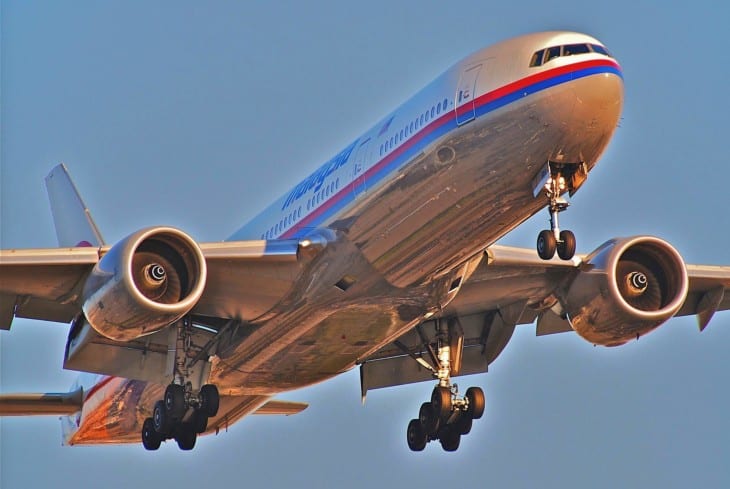
For more information about turbojet and turbofan engines, check out Chapter 15 of the Airplane Flying Handbook. Jet designs and systems are also covered in Chapter 7 of the Pilot’s Handbook of Aeronautical Knowledge. (see references below)
Conclusion
Turbojets are a legacy technology that you might not ever encounter in the 21st century. You’ll certainly see them in museums, and the technology changed the world.
Today, except for a few experimental and supersonic applications, the go-to for jet propulsion has become the turbofan. These engines are quiet and efficient. They will roar along all day long on the wing of your airliner or tucked safely inside your fighter jet.
References ▾
Related Posts
